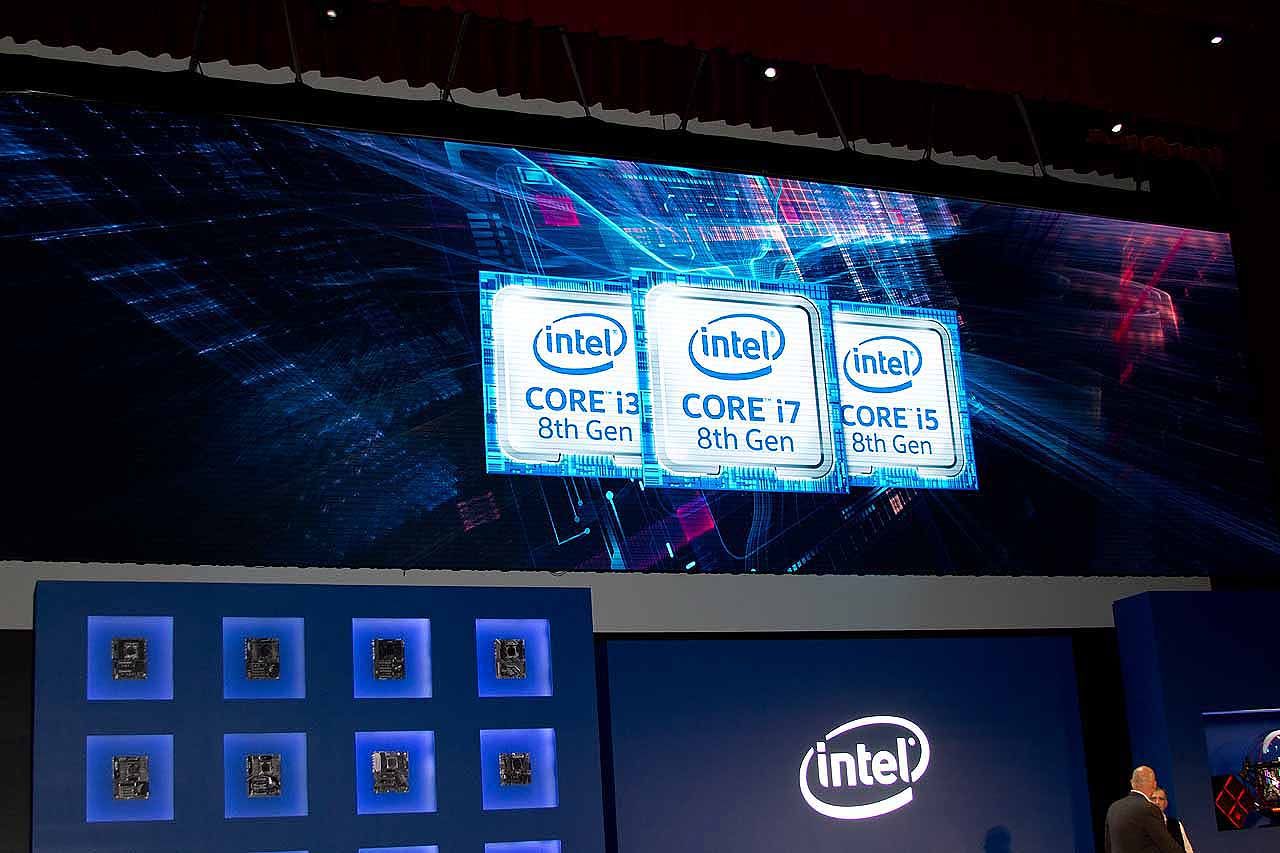Intel’s Coffee Lake Lineup Leaks Out

Intel’s new mainstream desktop Coffee Lake lineup appears to have been leaked via a picture from a distributor event in China.
The information lines up with previous leaks that also appear credible, though they were impossible to verify at the time. Chiphell posted a somewhat blurry picture of the projection screen at the event, but due to image ownership, we can’t share it. We have the next best thing, but we caution that our charts might contain slight errors due to image quality. Our sister site AnandTech has confirmed through external sources that the slide is genuine.
As per usual with any leak, we do have to caution that the information may not represent final, or even actual, specifications.
| Cores/Threads | TDP | Base/ All-Core Boost/ Single-Core Boost (GHz) |
Cache | Single-/ Multi-threaded Performance Gain |
Memory | |
| Coffee Lake i7-8700K |
6/12 | 95W | 3.8 / 4.3 / 4.7 | 12MB | 11% / 51% | DDR4-2666 |
| Kaby Lake i7-7700K |
4/8 | 91W | 4.2 / 4.4 / 4.5 | 8MB | – | DDR4-2400 |
| Coffee Lake i7-8700 |
6/12 | 65W | 3.2 / 4.3/4.6 | 12MB | 18% / 58% | DDR4-2666 |
| Kaby Lake i7-7700 |
4/8 | 65W | 3.6 / 4 / 4.2 | 8MB | – | DDR4-2400 |
| Coffee Lake i5-8600K |
6/6 | 95W | 3.6 / 4.1/4.3 | 8MB | 19% / 55% | DDR4-2400 |
| Kaby Lake i5-7600K |
4/4 | 91W | 3.8 / 4 / 4.2 | 6MB | – | DDR4-2400 |
| Coffee Lake i5-8400 |
6/6 | 65W | 2.8 / 3.8 / 4.0 | 8MB | 29% / 61% | DDR4-2400 |
| Kaby Lake i5-7400 |
4/4 | 65W | 3.0 / – / 3.5 | 6MB | – | DDR4-2400 |
Some of the readings are blurry, so we’ve italicized Coffee Lake entries that are open to interpretation. We also included the underlined specifications that we derived from leaked tables that appeared at AnandTech’s forum last month. Both sources feature identical specifications, lending at least some credence to the overall picture.
As expected, the 14nm++ Coffee Lake processors purportedly bring an additional two cores to bear for the i5 and i7 models outlined above. We notice a slight increase in TDP to 95W, which is negligible considering you gain two extra cores in exchange. We also see a bump up to 12MB of cache for the i7 models and 8MB for the i5 lineup.
The i7-8700K ostensibly provides some Turbo Boost frequency improvements, albeit with a few regressions in all-core Turbos, and lower base clocks across the board. The combination yields an 11% increase in single-threaded performance while heavily threaded workloads will gain an additional 51%, according to the leak. We see the same general trend for the i7-8700 with 18% and 58% gains, respectively. It’s impossible to determine how these metrics were derived, but it’s notable that Intel tends to focus on Sysmark and other benchmarks for early performance comparisons. The company used pre-silicon performance estimates that have a significant margin of error (+/- 7%) for the initial Coffee Lake reveal.
Most notably, the Core i5 models aren’t listed as including hyperthreading, so it appears the feature will remain a no-show for the mid-range processors. More physical cores is a welcome addition, though. The same general trends of more cores and cache, along with higher boost frequencies, applies to the i5 lineup as well.
Of course, pricing is still the wild card, and Intel will likely charge a small premium for the bulked-up offerings. Otherwise, it risks cannibalizing its existing Kaby Lake lineup while it is still in the supply chain. We also note that Intel continues with its “K” series branding, which denotes overclockable models via unlocked ratio multipliers. AMD has upset the traditional segmentation status quo with its universally unlocked multipliers, but Intel prides itself on its strict segmentation. That appears to continue.
| Coffee Lake i3-8350K |
Kaby Lake i3-7350K | Coffee Lake i3-8100 |
Kaby Lake i3-7100 | |
| Cores/Threads | 4 / 4 |
2 / 4 | 4 / 4 |
2 / 4 |
| TDP | 65W |
60W | 65W |
51W |
| Base Clock (GHz) | 4.0 | 4.2 | 3.8 |
3.9 |
| Cache | 6MB |
4MB | 6M |
3MB |
| Single- / Multi-threaded Performance Gain | 17% / 65% |
– | 16% / 61% |
– |
The image outlines increased physical core counts for the i3 lineup, as well. The i3 models may also come without hyperthreading. The slide also claims that, like the Kaby Lake products, Intel is not enabling Turbo Boost functionality for the i3 family. The i3 models become the “new” i5 with four physical cores like the Kaby Lake i5 series. This wasn’t entirely unexpected, as Intel already brought hyperthreading to its Pentium lineup, thus encroaching on the i3’s territory.
It remains to be seen if Intel will transition to a mesh architecture for the mainstream Coffee Lake lineup, but given the smaller die and core counts, it is unlikely. However, Intel did incorporate the new fabric with the existing Skylake architecture to create the Skylake-X models, so a similar adjustment is possible.
Of course, the all-important price-to-performance ratio will dictate the amount of success that Intel has against AMD’s finest. AMD recently finished launching its final Ryzen products (until the Vega- and Zen-equipped APUs come to market), but the company also has a solid roadmap for future architectural improvements to the Zen microarchitecture. That means we might see the two company’s trade salvos over the coming year as well.